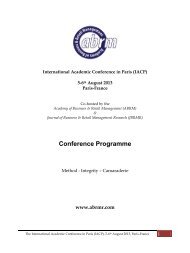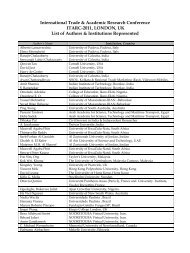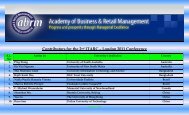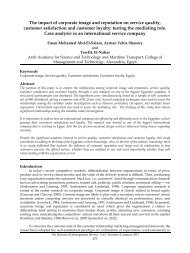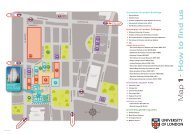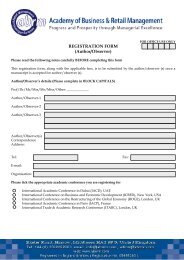ROGE - Pune 2011 - The Academy of Business and Retail ...
ROGE - Pune 2011 - The Academy of Business and Retail ...
ROGE - Pune 2011 - The Academy of Business and Retail ...
You also want an ePaper? Increase the reach of your titles
YUMPU automatically turns print PDFs into web optimized ePapers that Google loves.
International Conference on the Restructuring <strong>of</strong> the Global Economy, PUNE 1-2 February, <strong>2011</strong><br />
Pakistan got the first <strong>and</strong> sixth positions respectively, among the top arms importers.<br />
Both countries mostly buy arms from the top arms exporters including US, Russia,<br />
Germany <strong>and</strong> France. Now the changing pattern <strong>of</strong> world economy requires change in<br />
spending behaviour <strong>of</strong> both countries. This paper explores answers to 3 main<br />
questions. First, how much amounts each <strong>of</strong> India <strong>and</strong> Pakistan has spent on defence,<br />
after attaining the status <strong>of</strong> atomic power Second, what was the impact <strong>of</strong> this defence<br />
competition between Pakistan <strong>and</strong> India, on the economies <strong>of</strong> arms sellers Finally,<br />
what will be the impacts on the economic development <strong>of</strong> both countries, in the<br />
scenario <strong>of</strong> least possible spending on their defence programs Budgets <strong>and</strong> economic<br />
variables <strong>of</strong> India <strong>and</strong> Pakistan, <strong>and</strong> those <strong>of</strong> arms sellers have been analyzed, with a<br />
special focus on defence budgets <strong>of</strong> India <strong>and</strong> Pakistan. <strong>The</strong> paper concludes highly<br />
positive impacts on economic development <strong>of</strong> both India <strong>and</strong> Pakistan, in case <strong>of</strong> least<br />
possible spending on their defence programs.<br />
III.<br />
Globalisation <strong>and</strong> Impact on Indian Automobile Industry<br />
Vadood Javan Amani, <strong>Pune</strong> University, India<br />
Abstract<br />
<strong>The</strong> automotive sector is one <strong>of</strong> the core industries <strong>of</strong> the Indian economy,<br />
whose prospect is reflective <strong>of</strong> the economic resilience <strong>of</strong> the country. Continuous<br />
economic liberalization over the years by the government <strong>of</strong> India has resulted in<br />
making India as one <strong>of</strong> the prime business destination for many global automotive<br />
players.<strong>The</strong> Automotive industry in India is one <strong>of</strong> the largest in the world <strong>and</strong> one <strong>of</strong><br />
the fastest growing globally. India manufactures over 11 million 2 <strong>and</strong> 4-wheeled<br />
vehicles <strong>and</strong> exports about 1.5 million every year. It is the world's second largest<br />
manufacturer <strong>of</strong> motorcycles, with annual sales exceeding 8.5 million in 2009. India's<br />
passenger car <strong>and</strong> commercial vehicle manufacturing industry is the seventh largest in<br />
the world, with an annual production <strong>of</strong> more than 2.6 million units in 2009. In 2009,<br />
India emerged as Asia's fourth largest exporter <strong>of</strong> passenger cars, behind Japan, South<br />
Korea <strong>and</strong> Thail<strong>and</strong>. <strong>The</strong> automotive industry is at the core <strong>of</strong> India’s manufacturing<br />
economy. India is positioned to become one <strong>of</strong> the world’s most attractive automotive<br />
markets for both manufacturers <strong>and</strong> consumers. <strong>The</strong> resulting benefits to society-in<br />
economic growth, increased jobs, <strong>and</strong> stability for families employed by the<br />
automotive industry-are considerable. India is expected to top the world in car<br />
volumes with approximately 611 million vehicles on the nation's roads. According to<br />
Society <strong>of</strong> Indian Automobile Manufacturers SIAM, the total automobile sale in the<br />
domestic market was reported 1114157 units in January 2010, increasing by 44.9%.<br />
IV.<br />
Millennium Development Goals –Underst<strong>and</strong>ing Contemporary Change in Indian Economy<br />
Renita Dubey, Amity Institute <strong>of</strong> Competitive Intelligence & Strategic Management<br />
<strong>and</strong> Utparn Dubey, Birla Institute <strong>of</strong> Management & Technology, Greater<br />
Noida,India.<br />
Abstract<br />
This study investigates performance <strong>of</strong> the Indian economy in the context <strong>of</strong><br />
MDG .For the past decade recognition <strong>of</strong> the role <strong>of</strong> MDG has been rising.In the year<br />
2000, 189 UN member states including India set for themselves eight developmental<br />
goals, ambitiously entitled the 'Millennium Developmental Goals'. <strong>The</strong>y pledged to




